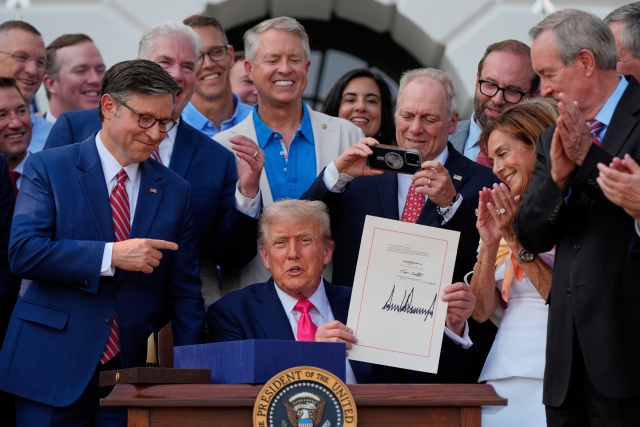With the signing of the American Tax, Security, and Prosperity Act—widely known as the "One Big Beautiful Bill"—the U.S. Congress has enacted the most consequential trade-related legislation for Chinese exporters in nearly a decade. While framed in Washington as a domestic economic package and Trump's MAGA accomplishment, the bill contains structural provisions that will redefine market access, regulatory risks, and supply chain pathways for manufacturers, particularly those in low-margin sectors like textiles, household goods, and cross-border e-commerce.

President Donald Trump holds his signed bill of tax breaks and spending cuts at the White House, Friday, July 4, 2025, in Washington, surrounded by members of Congress. (Photo: CFP)
The most immediate impact is the formal repeal of the de minimis exemption for duty-free imports under $800, a mechanism widely used by Chinese firms to ship goods directly to U.S. consumers. Starting July 2027, this channel will be shut down by law—not policy, and not discretion. Previously, attempts to end de minimis access had failed due to executive branch delays or agency pushback. The new legislation locks in a fixed repeal timeline that cannot be reversed without passing another bill through both houses of Congress.
This change is particularly significant for Chinese firms that have relied on direct-to-consumer (DTC) models via platforms like Temu, Shein, and AliExpress. The U.S. policymakers view these flows not as consumer conveniences but as threats to domestic jobs and enforcement integrity. Retailers that operate under the de minimis threshold will now face full tariff exposure, while warehouse operators and third-party logistics companies in China and Southeast Asia must restructure their shipping models.
In addition, the bill reflects a broader power shift: Congress is now leading U.S. trade and investment policy toward China. For years, Chinese exporters focused on signals from the White House, Department of the Treasury, Department of Commerce, or the USTR, but this is no longer sufficient. From 2025 onward, legislative action—not executive discretion—is becoming more influential in setting the outer limits of U.S.–China economic engagement. This means that future policy reversals will be extremely difficult, and ad hoc stabilization through new inter-governmental deals or dialogues may offer little practical relief for affected firms.
To illustrate this shift, the repeal of de minimis was not the result of a trade negotiation—it was passed as part of a multi-thousand-page domestic statute, alongside tax cuts and immigration enforcement. Even Trump's own executive order in April to end de minimis exemptions for China was later suspended due to logistical constraints. Congress simply codified what the White House could not enforce.
Congress's assertiveness goes beyond legislation like the de minimis repeal—it is actively reclaiming oversight over trade enforcement and customs authority. In April 2025, Senators Cantwell and Grassley introduced the bipartisan Trade Review Act (S.1272), a bill requiring presidential notification, economic justification, and congressional approval for any new tariffs beyond 60 days. Meanwhile, House members proposed the Congressional Trade Authority Act (H.R.1903) to formalize congressional limitations on executive authority under Section 232 of the Trade Expansion Act, effectively curbing presidential power to adjust trade for so-called national security reasons. While these measures are widely interpreted as checks on Trump's aggressive tariff practices, their long-term effect will extend well beyond the current administration—expanding Congress's role in trade policy through institutionalized oversight and a reinforced check-and-balance framework.
On the customs side, the Senate Finance Committee introduced the Customs Facilitation Act (S.956), granting U.S. Customs and Border Protection expanded authority for documentation and risk assessment on all imports—not just high-value shipments. Together, these moves indicate that Congress is rapidly building new levers of control over tariffs, customs processes, and trade enforcement—tools that will shape U.S.–China trade far into the future.
Chinese firms should be aware that this is not an isolated political cycle. Between now and the 2026 U.S. midterm elections, "being tough on China" will remain a bipartisan campaign staple as every member of the U.S. House of Representatives faces fierce re-election battles, and candidates are unlikely to support any measure perceived as "soft" on China. Even after the election, new lawmakers will be incentivized to show early strength on China-related issues. This means more trade and investment barriers are likely to emerge in 2026, not fewer. As partisan issues become harder to build consensus around, China-related economic policy—especially in trade and investment—will continue to serve as one of the few areas where lawmakers can claim tangible bipartisan achievements.
What does all this mean for Chinese exporters?
1. Duty-free pathways are ending. DTC and e-commerce models built on de minimis are on a countdown clock.
2. Tariff exposure will rise, and companies must begin scenario planning for 2027 now—not later.
3. Monitoring U.S. congressional activity is no longer optional and is vital. Even as Chinese firms familiarize themselves with the concepts of lobbying, legal review, and political risk analysis, they must now also cover Capitol Hill, not just the executive branch.
4. Policy reversals will be rare. Even if the Trump administration seeks "stabilization" with China, the legislative framework is locked in.
For China-based manufacturers and exporters, especially in textiles, consumer electronics, and low-margin goods, the path forward must now include contingency planning and re-assessment of long-term U.S. market strategies. Companies may consider adjusting product classification, rerouting value chains, or investing in regulatory capacity—including compliance audits and trade counsel—in anticipation of further restrictions. In particular, cross-border e-commerce platforms must revisit their U.S. strategy immediately.
Finally, this is not just a Trump-era trend. The legislative machinery behind this transformation has bipartisan support. It is no longer relevant whether Beijing and Washington hold more dialogues, or even whether short-term deals are signed. The most important constraints will come from domestic U.S. law, not international diplomacy. For companies in China, this means that the future of trade will not be negotiated—it will be legislated.
Chinese firms—particularly in export-oriented sectors—should begin building out internal capacities or partnerships with U.S. lobbying firms, law firms, and public relations firms for U.S. legislative tracking, legal analysis, and contingency planning. In the new era of statutorily defined U.S.–China competition, agility will depend not just on price and product—but on policy foresight.
This article was written by Alan Zhang, Research Associate and Manager, Trade and Technology Program, Institute for China-America Studies.
















